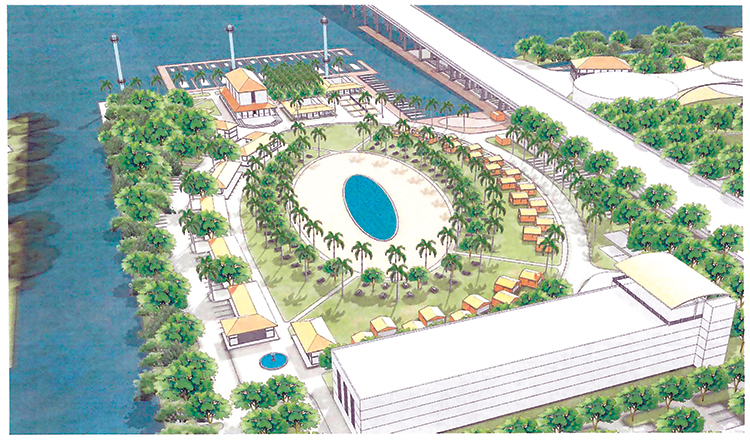
Vero’s Three Corners Steering Committee has recommended a version of the Master Concept plan for the mainland riverfront development at 17th Street to the Vero Beach City Council, but still unknown is whether a developer will want to salvage and repurpose the city’s shuttered Big Blue power plant.
By a 5 to 4 vote, the committee sent the “Community Plan” up to the council, with an amendment that the project could include residential development atop shops and businesses, in accordance with the city’s height restrictions.
Steering committee members pushing for less-intensive use of the lagoon-front land and more green space for recreation voted against the concept of people living on the property.
The City Council is expected to take up the committee’s recommendations in May and begin studying the feasibility of the project with a financial advisor. The steering committee was only tasked with turning ideas and a vision into a plan they could get behind – not with figuring out how to afford it or make it come to fruition.
Architect Andres Duany of DPZ CoDesign gathered community input for more than a year and incorporated the best and most popular of those ideas into the “Community Plan” approved on Monday.
The final plan was “very close to the standing ovation plan,” according to Vero Planning Director Jason Jeffries, referring to a meeting before the coronavirus pandemic where a substantially similar plan got a standing ovation from those in attendance.
The majority of the steering committee preferred that the massive, industrial Big Blue structure be converted into a hotel and event space with rooftop bar or restaurant, but if no developer willing to invest in that vision comes forward, the 60-year-old power plant will eventually be torn down.
Most steering committee members also wanted to find a way to reuse at least one of the huge concrete holding tanks that will be left once the wastewater treatment plant is decommissioned, but no specific proposal has been adopted by the city as to how they will be used or who will pay to retrofit them.
Other amenities on the wish list in the plan voted on by the steering committee include: restaurants, retail, flexible space for farmers markets and festivals, day docks, sand volleyball courts, water features, lush landscaping, a skate park, a fishing pier, bait shop, outdoor dining, restrooms, parking, a combination wedding chapel and meeting hall, an environmental education center or display, a sailboat platform, a boat ramp, a harbor, hotel cottages, a bike trail, a snack shack, stages, food truck sites, walkways, fountains and a visual and performing arts center.
The plan now in the City Council’s hands for the 37-acre site features a picturesque riverfront promenade with palm trees on the north side of the 17th Street-Alma Lee Loy bridge. The Youth Sailing Foundation’s training and competition facility is also included on the south side of the causeway.
Other than the Youth Sailing facility – a $3 million project for which nearly $1.5 million has already been raised or pledged to the Youth Sailing Foundation – there is no definite strategy to pay for any of the pricey amenities included in the plan. City staff is putting together a Request for Qualifications packets to attract developers who want to put a hotel, restaurants, retail and other ventures on the sites.
As the discussion got a bit sidetracked into the re-hashing of details of the plan, committee member Jeff Stasi reminded his fellow volunteer members that the onus will be on developers to decide which elements of the plan are financially viable and which are not.
“It’s not the city’s responsibility to make it profitable,” he said, adding that developers will only build what they feel the market will bear after analyzing the local economy and other factors.
City officials have said they don’t want to spend big bucks on the site’s amenities and that any costs would need to be offset by long-term lease and rental income or user fees so the project will be “revenue neutral.”
That means developers who bring money to the table will ultimately decide what is built on the riverfront parcel – within the parameters laid out by the city and approved by voters when the plan goes on the ballot, hopefully in November if the city settles on a plan specific enough to pose to voters by August.
The various plans – including the Community Plan that was approved, and a more recent plan that was rejected – can be found on the city’s website www.covb.org in the agenda packet for the April 26 Three Corners Steering Committee meeting, or on the Planning Department’s page.



